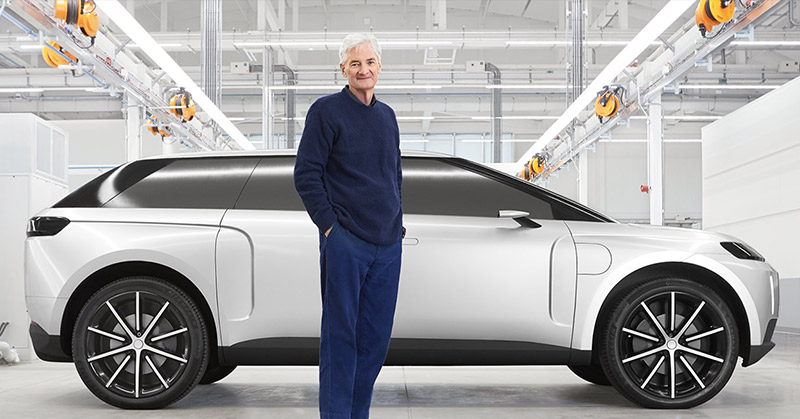In case you didn’t know, Dyson, the famed vacuum company, had an electric car in development until it was canceled last October. For a while, the automobile was a mystery, since only a few engineers had seen the working prototype. Then the company decided to reveal its electric car in an exclusive interview with the founder Sir James Dyson, 73, when he made the Sunday Times Rich List. With an estimated £16.2 billion ($19.7B USD) fortune, Dyson has topped the chart for the first time. [1]
“There’s huge sadness and disappointment. Ours is a life of risk and of failure,” Dyson says, confessing how devastated he was that the car won’t make it to the road. “We try things and they fail. Life isn’t easy.”
A Look Inside Dyson’s Prototype Electric Car
Dyson revealed that the electric car, codenamed “N526,” was a seven-seater with a 600-mile range per charge, which was largely due to the company’s solid-state batteries. These batteries could supposedly sustain this range “even on a freezing February night, on the naughty side of 70MPH on the motorway, with the heater on and the radio at full blast.” If this number was based on Europe’s WLTP standards, this car would have been ahead of the Tesla Model S’s 379 miles, and even more so from the long-range, seven-seater Model X’s 314 miles.
Although Dyson’s aluminum car weighed 2.6-ton, it could go from zero to 62MPH in 4.8 seconds, half a second more than the Model X. Its top speed could reach 125MPH. This power comes from the two 200kW electric motors with 536BHP and 480lb/ft of torque.
This car seemed to resemble a modern Range Rover, even more than patent diagrams would indicate. The SUV is said to be “five meters long, two meters wide and 1.7 meters tall,” with a windscreen that “rakes back more steeply than on a Ferrari,” and has wheels that “are bigger than on any production car on the market.”
The interior of the electric SUV is reminiscent of futuristic car concepts. The slim seats have portioned cushions and a lollipop-shaped headrest that’s designed to support the lumbar spine of the driver, and the three rows of passengers. “I hate those armchair-style seats that you sink into, because there’s never enough lumbar support and you get back pain,” says Dyson.
True to Dyson’s usual design quirks, the storage bins look similar to filing cabinets and the vital dashboard information like speed and navigation is presented in a head-up display that floats in front of the driver’s face like a hologram “so you never have to take your eyes off the road.” [2]
The Costly Failure of Dyson’s Electric Car
Many of these features are very ambitious for an electric car, and even more so for a company that focuses on household electric goods and haircare products. Dyson reported to the Times that the project cost £500 million ($611 million USD) out of his own pocket before he shut it down.
“Electric cars are very expensive to make. The battery, battery management, electronics, and cooling are much more expensive than an internal combustion engine,” he explains.
Dyson doesn’t have already-made profitable cars that run on gasoline and diesel to offset these losses, unlike actual car brands (with the exception of Tesla). Every Dyson electric car sold would need to earn £150,000 to break even. Tesla did report high profits in the beginning of this year, but now it has been reporting losses. At least Tesla electric cars are being sold and driven.
He explains that Audi, BMW Jaguar Land Rover, and Mercedes “are making huge losses on every electric car they sell. They’re doing it because it lowers their average CO and NO emissions overall, helping them to comply with EU legislation. I don’t have a fleet. I’ve got to make a profit on each car or I’d jeopardize the whole company. In the end it was too risky.”
When Dyson’s car was first announced, critics wrote it off as a vanity project doomed to fail, pointing at Tesla’s failed profit. Dyson counters this. “It was not a vanity project at all,” he retorts. “When we started in 2014, we had good technology and a very efficient car with a long-range. It was viable. But when, later, other companies started producing electric cars at a loss, it became too risky for us.” [3]
Read: Scientists Create Liquid Fuel That Can Store The Sun’s Energy For Up to 18 Years
Keeping the Garage Door Open
Although the dream of Dyson’s car has ended, it may have still left its mark. Dyson stated that the team of 500 is working on multiple other projects, including research into robotics, batteries, lighting, and air treatment. He added that he is open to allowing carmakers to turn to his solid-state batteries, which are said to be more compact and efficient than the commonly used lithium-ion cells. When asked if his company would attempt making cars again, Dyson said they would only if becomes commercially viable.
“The garage door never closes,” he says.
[1] “The Rich List 2020.” The Sunday Times.
[2] “Dyson finally unveils its canceled electric car.” Engadget. Richard Lai. May 17, 2020
[3] “How James Dyson, Britain’s Richest Man, Blew $600 Million on an Electric Car to Rival Tesla.” The Sunday Times. John Arlidge. May 16 2020

